Contents
| Walsura | |
|---|---|
 | |
| Walsura trifoliolata | |
| Scientific classification | |
| Kingdom: | Plantae |
| Clade: | Tracheophytes |
| Clade: | Angiosperms |
| Clade: | Eudicots |
| Clade: | Rosids |
| Order: | Sapindales |
| Family: | Meliaceae |
| Subfamily: | Melioideae |
| Genus: | Walsura Roxb. |
| Walsura | |
|---|---|
 | |
| Walsura trifoliolata | |
| Scientific classification | |
| Kingdom: | Plantae |
| Clade: | Tracheophytes |
| Clade: | Angiosperms |
| Clade: | Eudicots |
| Clade: | Rosids |
| Order: | Sapindales |
| Family: | Meliaceae |
| Subfamily: | Melioideae |
| Genus: | Walsura Roxb. |
Species accepted by the Plants of the World Online as of February 2023: [2]
Some Walsura species may be used for skin troubles and strengthening loose teeth.[ citation needed ]
Meliaceae, the mahogany family, is a flowering plant family of mostly trees and shrubs in the order Sapindales.

Cassia is a genus of flowering plants in the legume family, Fabaceae, and the subfamily Caesalpinioideae. Species are known commonly as cassias. The genus includes 37 species and has a pantropical distribution. Species of the genera Senna and Chamaecrista were previously included in Cassia. Cassia now generally includes the largest species of the legume subtribe Cassiinae, usually mid-sized to tall trees.
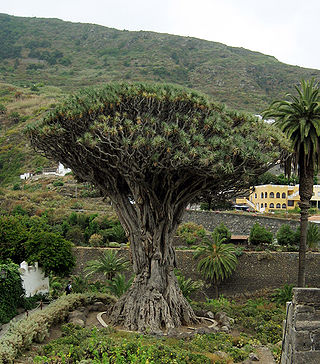
Dracaena is a genus of about 120 species of trees and succulent shrubs. The formerly accepted genera Pleomele and Sansevieria are now included in Dracaena. In the APG IV classification system, it is placed in the family Asparagaceae, subfamily Nolinoideae. It has also formerly been separated into the family Dracaenaceae or placed in the Agavaceae.
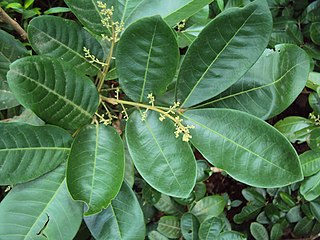
Aglaia is a genus of 121 recognised species of woody dioecious trees in the mahogany family Meliaceae. They occur in the subtropical and tropical forests of Southeast Asia, northern Australia and the Pacific.
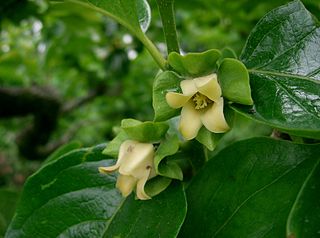
Diospyros is a genus of over 700 species of deciduous and evergreen trees and shrubs. The majority are native to the tropics, with only a few species extending into temperate regions. Individual species valued for their hard, heavy, dark timber, are commonly known as ebony trees, while others are valued for their fruit and known as persimmon trees. Some are useful as ornamentals and many are of local ecological importance. Species of this genus are generally dioecious, with separate male and female plants.

Manilkara is a genus of trees in the family Sapotaceae. They are widespread in tropical and semitropical locations, in Africa, Madagascar, Asia, Australia, and Latin America, as well as various islands in the Pacific and in the Caribbean. A close relative is the genus Pouteria.
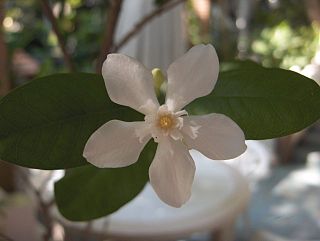
Wrightia is a genus of flowering plants in the family Apocynaceae, first described as a genus in 1810. It native to tropical Africa, China, the Indian Subcontinent, Southeast Asia, Papuasia, and Australia. The species are all small trees or shrubs.

Dysoxylum is a genus of rainforest trees and shrubs in the flowering plant family Meliaceae. About 34 species are recognised in the genus, distributed from India and southern China, through southeast Asia to New Guinea, Solomon Islands, and Australia. The name Dysoxylum derives from the Greek word ‘Dys’ meaning "bad" referring to "ill-smelling" and ‘Xylon’ meaning "wood".

Canthium is a genus of flowering plants in the family Rubiaceae. They are shrubs and small trees. The leaves are deciduous and the stems are usually thorny.

Fagraea is a genus of plants in the family Gentianaceae. It includes trees, shrubs, lianas, and epiphytes. They can be found in forests, swamps, and other habitat in Asia, Australia, and the Pacific Islands, with the center of diversity in Malesia.

Hopea is a genus of plants in the family Dipterocarpaceae. It contains some 113 species, distributed from Sri Lanka and southern India to the Andaman Islands, Myanmar, southern China, and southward throughout Malesia to New Guinea. They are mainly main and subcanopy trees of lowland rainforest, but some species can become also emergent trees, such as Hopea nutans.

Willughbeia is a genus of plant in the family Apocynaceae, first described as a genus in 1820. It is native to Southeast Asia with a few species in the Indian Subcontinent. Several species have edible fruits enjoyed in many countries. Many species are vines with sticky latex.

Mitragyna is a genus of trees in the family Rubiaceae found in the tropical and subtropical regions of Asia and Africa. Members of this genus contain antimalarial and analgesic indole alkaloids.

Hymenodictyon is a genus of flowering plants in the family Rubiaceae. It has about 30 species. All are native to the Old World. The wood of Hymenodictyon orixense is soft and has limited use, mostly for boxes. The type species for Hymenodictyon is Hymenodictyon orixense.

Chisocheton is a genus of trees in the family Meliaceae. The genus name comes from the Greek schizos and chiton meaning "split tunic", referring to the lobed staminal tube of C. patens. Their range is from India and tropical China, throughout Malesia and south to New South Wales and Vanuatu.

Dichapetalum is a genus in the plant family Dichapetalaceae. The plants are tropical lianas native mainly to tropical regions of Africa, Asia, Malesia, the West Indies, Australia and Latin America. Some species are known to be poisonous due to the presence of toxic fluorinated compounds such as fluorocarboxylic acid and dichapetalins, a unique class of cytotoxic compounds that are only found within this genus.
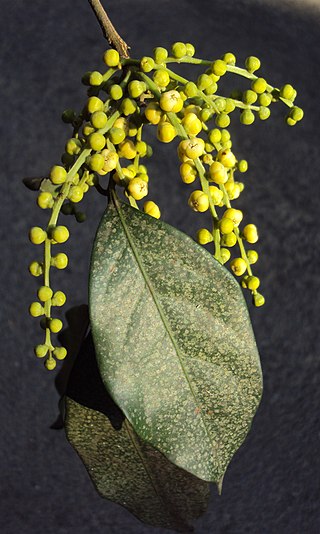
Reinwardtiodendron is a genus of plants in the family Meliaceae, described by Sijfert Hendrik Koorders and found in south-east Asia. The type species is: R. celebicum Koord.
Pancovia is a genus of flowering plants belonging to the family Sapindaceae.

Hymenodictyon orixense is a species of flowering plant in the family Rubiaceae. It is found in the Indian Subcontinent, south-central China, Mainland Southeast Asia, and the Philippines.